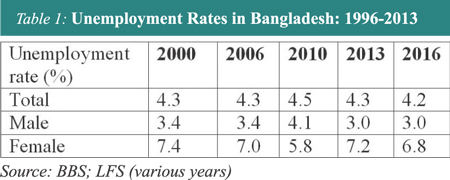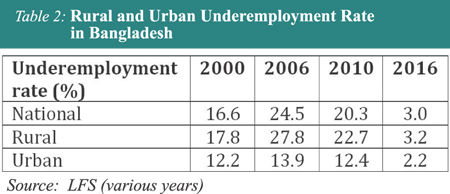 Bangladesh and other densely-populated South Asian countries are viewed as surplus labour economies and the development theories say that economic growth will take place through utilisation of the surplus labour. Whether development is taking place along this route requires monitoring which can be done on the basis of data on unemployment. Therefore, along with the data, the appropriateness of the indicator should be examined critically. The concept of "open involuntary unemployment" has been developed in the context of industrial economies and, therefore, its applicability to low income developing economies of South Asia has been doubted.
Bangladesh and other densely-populated South Asian countries are viewed as surplus labour economies and the development theories say that economic growth will take place through utilisation of the surplus labour. Whether development is taking place along this route requires monitoring which can be done on the basis of data on unemployment. Therefore, along with the data, the appropriateness of the indicator should be examined critically. The concept of "open involuntary unemployment" has been developed in the context of industrial economies and, therefore, its applicability to low income developing economies of South Asia has been doubted.
The present discussion presents data on the unemployment rate in Bangladesh and highlights the problems of data from national sample surveys. Data based on an alternative concept of underemployment is also presented along with suggestions for improvement of the database for measuring surplus labour.
The unemployment rate in Bangladesh (based on Labour Force Survey of Bangladesh Bureau of Statistics-BBS) appears to be incredibly low, lower than the current rates in many high income industrial economies. Data from the Labour Force Surveys (LFS) during the period of 2000-2016 show that the unemployment rate in Bangladesh was in the range of 4.0 to 5.0 per cent (Table 1). A discussion on the definition and data generation process contributing to such a low rate of unemployment can also help make a proper interpretation of the data and seek alternative ways to estimate underutilisation of labour force.
The problems with application of the definition arise from several sources. First, the survey question for identifying the unemployed is such that few people fit into that category. It consists of two parts: 'whether one was without work for last one week (a reference period) and whether one was willing to work or was looking for work or trying to start self-employment". Being "without work" can be afforded only by persons from rich households.
Another feature of the definition used by LFS is that during the reference week, only one hour spent on income earning activities is enough for being counted as "employed" and, therefore, the chances of being unemployed are low. This liberal definition is also responsible for giving a high labour force participation rate as well as a high ratio of the 'employed' to the total population. The scope of employment for only a few hours a week is very high in Bangladesh's labour market where self/family employment is predominant. People who want to do work can easily spend a few hours a week in taking care of the family's livestock, kitchen garden or other family enterprises. In urban areas, entry into the low productive informal sector may provide a scope for employment with ease of entry.
An additional source of under-enumeration of unemployment is the form of the questions used in the interview, which asks "whether one was looking for jobs or trying to start self-employment". This lacks practical applicability. In the informal labour market in the rural areas where there are no formal routes of job search, most people without work are not involved in the actual search process. Employers in the rural areas may approach them when there is a need. Petty self-employment may not require any prolonged period of "trying to start". Moreover, women who wish to work may not go for job search because of social inhibition and may not report that they are willing to work. Thus the social reality makes the concept of open unemployment inapplicable for large segments of the prospective labour force and contributes to low figures of unemployment rates.
The problems with application of the concept of open unemployment have led to the use of an alternative concept termed "underemployment rate". This can provide a better measure of surplus labour when only a part of the workers' time is unused.
A number of alternative criteria have been suggested for measuring underemployment. The time criterion is the most commonly used concept of underemployment in Bangladesh. While the "time criterion" of underemployment is based on a comparison of actual hours worked and hypothetical norms, various other methods of estimation of surplus labour/underemployment were used in the past studies in Bangladesh and India.
 The concept of "disguised unemployment" in the sense of work sharing by family workers which takes place due to inadequate employment opportunities has also been used in this context. With the rapid decline of the joint/extended family systems, "disguised unemployment," which applies more appropriately to family workers is giving way to open underemployment.
The concept of "disguised unemployment" in the sense of work sharing by family workers which takes place due to inadequate employment opportunities has also been used in this context. With the rapid decline of the joint/extended family systems, "disguised unemployment," which applies more appropriately to family workers is giving way to open underemployment.
The "willingness criterion" is being used consistently for empirical estimation of unemployment in India in all rounds of their national sample surveys. This can be applied to both family workers and hired labourers who are in the disguised or open underemployment situation and are willing to work more.
Bangladesh's Labour Force Survey and a number of other studies based on micro surveys have used the "time criterion" (on the basis of various cut-off lines as standard hours) to measure the underemployment rate. The LFS of Bangladesh has set the cut-off line for full employment at 35 hours per week and those who work less are counted as underemployed. Comparable data on the basis of the time criterion are available for 2000 to 2010. Underemployment rates disaggregated by location (rural-urban) are shown in the Table 2.
 The underemployment rate increased from 16.6 per cent in 2000 to 24.5 per cent in 2006 and decreased slightly in 2010 when it stood at 20.31 per cent. Underemployment rates are higher in the rural areas compared to the urban areas of Bangladesh (Table 2), which is not unexpected. In the rural areas most of the underemployed workers can derive a livelihood through resorting to work sharing with other family members and drawing upon the family's consumption basket.
The underemployment rate increased from 16.6 per cent in 2000 to 24.5 per cent in 2006 and decreased slightly in 2010 when it stood at 20.31 per cent. Underemployment rates are higher in the rural areas compared to the urban areas of Bangladesh (Table 2), which is not unexpected. In the rural areas most of the underemployed workers can derive a livelihood through resorting to work sharing with other family members and drawing upon the family's consumption basket.
From 2016, the LFS has modified the definition of underemployment. Only 3.0 per cent were underemployed by this new definition, which is far less than the figures for previous rounds. Such low figures may provide wrong signals discouraging policy initiatives for employment growth.
In this round (QLFS 2016) a combination of three criteria has been used to define underemployment. These are:
i) Willingness to work additional hours
ii) Availability to work additional hours
iii) Having worked less than 40 hours per week
The reasons behind such low figures of underemployment rates are due to the combination of the three criteria. The problems arising from the definition include the following:
This definition leaves out those who have worked more than the cut-off hours but were still willing to work more because they know that there will be inadequate work in the slack season.
The other problem is that it would be very difficult to distinguish between willingness and availability to work more. This becomes even more impractical because the survey is administered by interviewing the head of the household, who may not have full knowledge about the "willingness" of all members.
This measure applies only to currently employed persons. However persons who are outside the labour force during a quarter may be willing to work and have moved out of the workforce because they know that no work is available.
The new definition has been used following the ILO's definition so that international comparability is ensured. One has to consider whether international comparability offers a significant advantage or not. If it is at the cost of ending up with data not suitable for domestic policy options, one may have to reconsider the definition issue.
If there is an overriding reason for adopting the ILO definition, this may be done in addition to a more relevant estimate of surplus labour for domestic policy adoption. For example, an alternative estimate may be obtained using only the willingness/availability criterion. Moreover, it may be applied to everyone in the labour force in any quarter during last one year.
The decision to adopt a definition relevant to the domestic policy has to be based on a consensus among all stakeholders so that it is not reversed in near future. This will ensure that a consistent series of data on the underemployment rate can be generated which will give a clear picture of the surplus labour trend in the economy.
Rushidan Islam Rahman, PhD is a member of the Board of Directors of Bangladesh Bank and Executive Chairperson of the Centre for Development and Employment Research (CDER).
© 2024 - All Rights with The Financial Express
